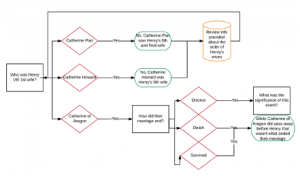4 Adaptive Learning
Carrie Lewis Miller
Learning Objectives
- Explain Adaptive Learning
- Recommend Adaptive Learning Solutions for your own organizational context
- Identify tools for use to create adaptive learning experiences
- Create a -Mini Adaptive Learning Experience
- Plan multiple methods of creating adaptive learning experiences
Adaptive learning is an interactive method that generally harnesses the logic of computers to create individualized pathways for student learning. The adaptive learning environment guides a learner through the content based on responses to a series of knowledge checks, increasing or decreasing the complexity of the content as indicated by the learner responses.
Commercial adaptive learning solutions exist, and companies, such as Dreambox and Knewton, provide adaptive learning platforms for instructors to use. Many textbook publishers, such as Pearson and McGraw-Hill, have created adaptive learning software packages as online tools or “labs” for students to explore and practice. Most learning management systems can be utilized to create adaptive learning experiences on a smaller scale.
Adaptive learning is often a fundamental component of gameplay. For those who have played commercial video games, you may have experienced the difficulty or complexity of the game increasing as you make “correct” choices in your character’s actions. Some games will introduce varying scenarios based on a particular player’s choices while playing the game, increasing the personalization and replayability of the game.
It is important to distinguish between game-based and adaptive learning, however. While game-based learning may contain adaptive learning elements, adaptive learning may not always contain game mechanics in its design.
Traditionally, adaptive learning by definition includes the use of computers. I would argue that because the fundamental component of adaptive learning is the idea of personalized learning pathways, based on user responses or choices, adaptive learning experiences can be built into a learning experience without the need for technology.
At the heart of adaptive learning is the learning pathway. Learning pathways are built using branching logic, also known as conditional branching. Most often used in reference to online surveys, branching logic maps out the possible response paths a user can choose when interacting with an online experience. For all intents and purposes, branching logic is a map to all possible avenues a student can take to approach a learning experience. The example below in Figure 3 might be a possible adaptive learning pathway to a lesson on the wives of Henry VIII of England. Each correctly answered question or completed task propels the learner further through the content. For each incorrect answer, feedback and opportunities for review are provided. Rather than just questions, content information could be provided at each critical junction (represented by the squares). Possible responses are noted in the diamond shapes. Formative feedback is represented in the ovals with review information in the cylinder.

Figure 3: Henry VIII branching logic example for an adaptive learning strategy.
Questions for Discussion
- What does Adaptive Learning mean to you? How would Adaptive Learning fit into your organization’s teaching and learning framework?
- Identify a tool that you could use to create an adaptive learning experience. Why did you pick this tool? Is it free? Is it easy to use? Is it already available at work? What makes this tool adaptive? What kind of learning experiences can you build with it?
- Choose a topic at the Khan Academy website (https://www.khanacademy.org/) or explore a site like Duolingo (https://www.duolingo.com/). Take about 20 minutes to complete a lesson or two of your choice. What was the adaptive experience like? Could you tell that the system was adapting to your learning needs? As a student do you feel that this helped you learn more? Why or why not? What topic/lesson did you explore and what your skill level with the subject was before you started the lesson?
- Look at the available tools at your disposal to create an adaptive learning experience. Which tool suits your needs best and why? What is the first step to creating an adaptive learning lesson?
- Reflection: Evaluate the game or simulation you have chosen to play. What are the pros and cons of this game or simulation? Would you recommend it to a friend? Why or why not? Does it satisfy your needs as a game player, based on your Bartle’s Test results?
Recommended Supplementary Material
- Kerr, P. (2016). Adaptive learning. ELT Journal, 70(1), 88-93. https://doi.org/10.1093/elt/ccv055
- Essa, A. (2016). A possible future for next generation adaptive learning systems. Smart Learning Environments, 3(1), 1-24. https://doi.org/10.1186/s40561-016-0038-y
- Shedding Light on the Adaptive Black Box: Adaptive Learning Close Up
- You Are Not So Smart Podcast, Episode 053 – Adaptive Learning – Ulrik Christensen

